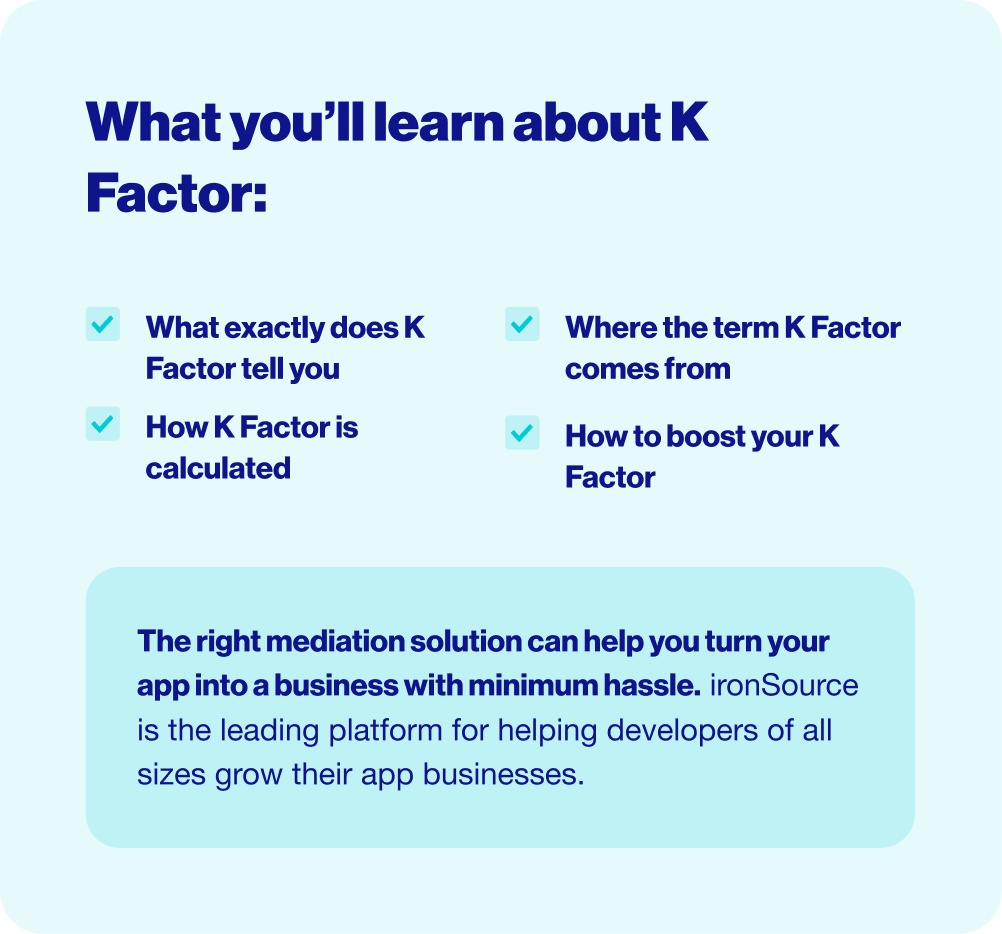Every app developer wants to understand how their app’s user base is growing, and how viral the app is. For this, look no further than your app’s K Factor.
But what exactly does K Factor tell you about your app’s growth? And how can you work yours out?

What is K Factor?
K Factor is a metric for app developers that reveals your app's virality, by measuring how many additional users each of your existing users brings along to the app.
The term K Factor actually comes from the world of medicine, where it's used as a metric to measure how quickly a virus spreads.
The simplest way to understand K Factor and make the most of the insights this metric brings is to apply it during UA campaigns - basically revealing how many new users your paid UA campaign users bring to the app.
How is K Factor calculated?
It’s quite challenging to get a true value for K Factor, because it’s very difficult to pinpoint exactly why an organic user installed your game. Employ the metric during UA, however, and it can be easier to understand where those organic users are coming from.
If you want to get the purest understanding of K Factor, try this simple hack:
Find a country where you have almost zero daily organic downloads. Then buy a certain amount of users - let’s say in this case you buy 10,000 users. If you see that after a specific period of time you suddenly have 12,000 users, you know that 2000 of them came as an indirect result of your paid user acquisition campaign.
So, your K Factor is 1.2.
A K Factor higher than 1 is considered viral, and the higher the K factor, the better. Why? Because it means an active user of your app acquired through a UA campaign tells many other people about your app, who themselves become organically acquired - hopefully active - users.
Why is K Factor so important?
Think of K Factor as the interest rate on your investment in user acquisition. It helps you understand how well your inorganic growth affects your organic growth.
It also can help you spend more efficiently on user acquisition campaigns. Use a small budget to test your app in various countries, and then invest more heavily in the ones with the highest K Factor.
A successful UA campaign also means you are more likely to climb the App Store charts, increasing chances of organic user discovery. A successful UA campaign can also mean that more users spread news of your app via word of mouth. Both outcomes result in a higher K Factor, a positive return on the investment in UA.
Understanding your K Factor also gives you greater insight into the effectiveness of the sharing capabilities built into your app, and what kind of incentives your existing users need in order to recommend the app to someone else.
How can you get more viral and boost your K Factor?
1. Make it easy to share your app
That means integrating plenty of traffic drivers into the flow of your app - like giving users chances to ‘share their high score’ with friends, or making it easy for them to ‘invite a friend to play’.
Don’t make it difficult, or overly complicated (think multiple permissions or additional logins) for a user to invite a friend.
2. Incentivize the 'inviter' sending an invitation to the app
As rewarded videos have demonstrated, rewarding user action with in-game currency, discounts or other rewards can be very impactful. Create rewards to incentivise a user who signs up a friend to the app as well. If users send a special code or referral message to a friend to sign up to the app, it also makes it easy to measure which existing users invited the most converting users.
Strengthen this strategy by offering these traffic drivers at optimal times. For example, if a user just lost a life, offer them the chance to win 3 more by inviting a friend to install the app.
3. Incentivize the 'invitee'
Existing users are more likely to refer their friends to an app if there is also a reward for the invitee - they’re giving their friends a valuable reward - so adding a reward for the invitee as well as the inviter is another way to increase your K Factor.
So, provide new users with a reward for installing, but ensure that the reward is meaningful to them at the time of download. For example, they may not yet understand the value of ‘10 coins’ in-app, as they haven’t played the game yet.
Instead, offer them an exciting premium feature - such as a new character or sword - as a discount on in-app purchases that they can use once they start playing. Everyone understands the value of 50% off! Let the new user know that their friend also gets rewarded if they install the app.
4. Work on the product
The easiest way to get your app to go ‘viral’, is to make a great app! This sounds obvious, but if your app is really useful for users, or a game that users just love, they are more likely to share it with their friends. Invest the time into making the product the best it can be.
5. Reach the right audience
Once you begin to understand your K Factor, use the information to optimize your UA spend. Once you know what kind of users drive your K Factor, you can adjust your campaign spend to go after them. For example, perhaps you see that female users in Mexico have an average K Factor of 1.8, and female users in Germany have a K Factor of 1.2. Your ad spend would be best directed to UA to the first group, as they will bring in more organic users. Remember, K Factor is the interest on your UA spend, so make it count!


